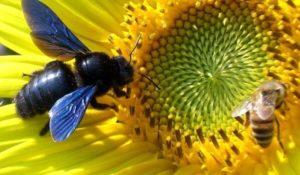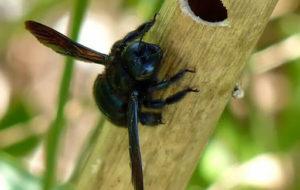Carpenter Bumblebee or Xylop Black Bee: Unique Construction Set
Everyone knows bees. These are striped honey plants with a little wool, which are always busy with their duties. They are constantly on the move, flying from place to place on flowers in spring. But there are species that do not fit into the general understanding of the family and color of bees - carpenters.
Content
Bee carpenter: photo
general description
Name: bee carpenter, xylopa
Latin: Xylocopa valgaClass: Insects - Insecta
Squad: Repomoptera - Hymenoptera
Family: Real bees - Apidae
 | Habitats: | forest-steppe, edges |
 | Lifestyle: | single bee |
 | Features: | good pollinator, member of the Red Book |
The carpenter bee is a solitary bee species. She looks very bright and colorful. The insect is hardy, flies far and perfectly pollinates different types of plants.
The size is impressive, by the standards of the family, the carpenter is a large bee, its body reaches a size of 35 mm. The color of the body is black, it is completely covered with hairs. The wings are blue-violet. Often they are called bumblebees.
Habitat
The carpenter bee lives on the edges of forests and in thickets. It occupies places in the dry wood. At the moment, the carpenter or xylopa is a rare representative, there are about 730 varieties. Due to the fact that the natural habitat is now being actively cut down, their numbers are significantly reduced.
The very name carpenter implies a way of life. They like to build a place in the remnants of wood. And for a descendant, she even makes a separate nest. It works very quickly and loudly, like a drill.
Life cycle
The female already in the spring begins to build a place for her offspring. In wood, she makes ideal compartments for children, nectar and pollen fit inside to make it soft. These cells have perfectly smooth edges. The passages to the cells line up along the fibers.
When the larvae wake up, they feed on reserves and hibernate there. Only when it gets warmer do they gnaw their way out and fly out.
Character and features
The carpenter is a completely non-aggressive bee. She won't attack first. If it is not hooked, then it will not touch a person on its own. But, if you force a xylopus to bite, you can seriously suffer.
Its sting is more painful than that of an ordinary bee. A large amount of poison that enters the wound causes burning, soreness and an allergy attack. Often there was an anaphylactic shock and there was a fatal outcome.
Facts and Features
It is interesting that people want to tame the carpenter's bee in order to get honey from it, as from domestic ones. But nothing works.
Carpenters fly very far and are not afraid of rain or bad weather.
Unlike ordinary bees, carpenters do not suffer from bee mites.
Carpenters can collect pollen even from those flowers that have one long corolla.
Conclusion
The carpenter bee, which looks more like a large fly in appearance, is quite cute and harmless if left untouched. Xylopa is a rare species, meeting with it is rare. It is better to let the bee go about its business, for the sake of its own safety and the preservation of the species.

